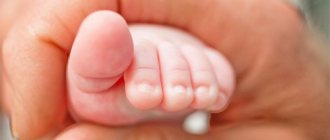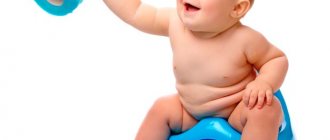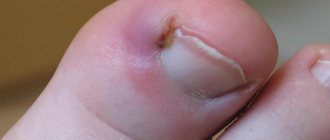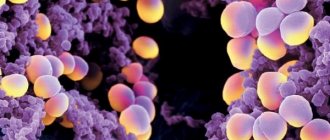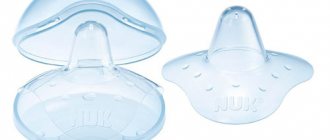Cases of jaundice in newborn babies are common. Breast milk jaundice is a type of physiological jaundice that can occur in a newborn during breastfeeding.
Unfortunately, very often women who are faced with this problem are advised to stop breastfeeding or are advised to switch the baby to formula or pasteurized breast milk, for fear of worsening the child’s condition. Is this really necessary? Or you can breastfeed your baby without fear. Let's talk about this in detail and consider all possible options.
Causes of jaundice in newborns
The accumulation of bilirubin in the blood in large quantities can be caused by the following reasons:
- Increased formation of bilirubin due to hemolysis (increased destruction of red blood cells). If jaundice is formed as a result of this factor, it will be called hemolytic. The reason for the occurrence lies in the Rh conflict between mother and fetus. In this case, the woman in labor must have a negative Rh factor, and the fetus must have a positive one. According to statistics, hemolytic disease occurs in 10% of children with Rh conflict. Hemolytic disease can also be caused by large blood loss during childbirth, hereditary factors, etc.
- Lack of conversion of free bilirubin to bound bilirubin. This most often occurs due to imperfections of the liver enzymes that are responsible for this process, or due to their weak activity.
- Inherited liver enzyme deficiency. This disease in medicine is named after Crigler-Nayyar.
- Reaction to breastfeeding. Such jaundice begins to appear more often in the second week of life. It goes away on its own without stopping natural feeding and specialized treatment by 3 months. The reason lies in the fact that the milk received by the child from the mother contains a large number of hormones that affect the activity of liver enzymes, reducing it.
- Reaction to drugs. Jaundice can occur when taking certain antibiotics, hormones, and sulfa drugs. This is due to their ability to influence the process of bilirubin binding.
- Hypoxia and asphyxia during childbirth can cause the development of jaundice.
- Infections.
- Birth injuries.
- Diabetes mellitus in the mother.
- Congenital hypothyroidism. In addition to changes in the color of the skin, the child experiences dry skin, swelling, rough crying, and developmental delay.
- Fusion of the bile ducts (complete or partial), or underdevelopment of the bile ducts, which is a mechanical barrier to the outflow of bile. These causes relate to congenital malformations.
- Intestinal obstruction.
- Thickening of bile, which is observed if the child suffers from hemolytic disease.
- Pyloric stenosis is a congenital narrowing of the pylorus. More often seen in male infants.
- Congenital hepatitis caused by intrauterine infection (rubella, syphilis, toxoplasmosis, cytomegalovirus, etc.).
- Hepatitis acquired after birth.
Diagnostics
To identify jaundice, you need to conduct a comprehensive examination. There are 2 methods for assessing the volume of bilirubin in a baby’s body:
- Traditional - in such a situation, a biochemical study is carried out;
- Specific - a special device is used for the procedure, which is called a transcutaneous bilirubinometer and does not require blood sampling.
To determine the relationship between jaundice and lactation, it is enough to wean the baby for a few days. When the volume of bile pigment decreases by 20% or by 80-170 µmol/l and the yellowness of the epithelium decreases on the first day, we can say that the cause of the problems lies in breast milk.
Consequences of jaundice in newborns
If jaundice in newborns is a physiological phenomenon, then it will go away naturally, without causing any consequences or complications. The situation is different if the child suffers from pathological jaundice. It lasts more than a month, while the feces become discolored, the skin acquires a greenish tint, and the urine, on the contrary, darkens. Ultrasound most often shows an enlarged liver and spleen.
If such signs are observed, then it will not be possible to do without medical help.
If treatment is not prescribed on time, the newborn may face the following consequences:
- Excess bilirubin will accumulate in adipose tissue, in the membranes of (lipid) nerve pathways, and in the nuclei of the brain. At high concentrations of this biochemical substance, toxic poisoning of the body occurs.
- Bilirubin encephalopathy may develop.
- Delayed neuropsychic development, which may not appear immediately, but at an older age.
- A high content of bilirubin causes albuminemia, as it reduces the amount of albumin in the blood. The condition is further aggravated by increased capillary permeability in newborns. The development of albuminemia will be indicated by edema and the presence of protein in the urine, with a high level of bilirubin.
- The appearance of increased frequency of seizures, the development of deafness, which is associated with the accumulation of bilirubin in the brain and the development of kernicterus.
- If the disease is advanced, this is fraught with frequent involuntary muscle contractions and loss of control over one’s own movements. Oligophrenia may develop.
The consequences of the disease directly depend on what caused the jaundice of the newborn. If this is a pathological condition, then it definitely needs treatment.
Possible complications
If you follow the doctor's recommendations, physiological jaundice ends in complete recovery. In rare cases, complications develop. The main ones are:
- Toxic poisoning of the central nervous system.
- Hearing loss or limb paralysis.
- Slow mental development.
- General intoxication of the body.
- Liver failure.
- Albuminemia.
- Bilirubin encephalopathy.
If the technology for using a UV lamp is violated, burns, dehydration, hemolysis, or the development of the inability to digest lactose can occur. You should also remember about preventive measures. These include regular sunbathing, good nutrition for the mother, and giving up bad habits. Jaundice is prevented by cutting the umbilical cord within the first 2 hours after birth.
When does jaundice go away in a newborn?
The time it takes for jaundice to go away may vary depending on the causes that caused it and other factors. Thus, in premature babies it is somewhat more complicated than in full-term babies; yellowness of the skin can be observed for two weeks. Even a factor such as insufficient nutrition, with low lactation in the mother, can cause jaundice to last for a longer period.
On average, in full-term babies, the last symptoms of jaundice disappear after a week. The maximum period during which residual effects can be observed is 21 days. But in this case we are talking about physiological jaundice, which does not require specialized treatment.
Is prevention possible?
In practice, neonatal jaundice occurs much more often in premature babies. Therefore, preparatory measures should begin even before the birth of the child, and the pregnant mother must comply with them. Premature prevention consists of a healthy diet, absence of alcohol and cigarettes, and taking vitamin complexes.
If it is still not possible to avoid the disease, the best way to support the baby will be breast milk. After all, it contains all the vital substances that are so necessary for a child under the age of 1 year. And it is impossible to provoke an overdose with breast milk, unlike medications.
Why does a baby's jaundice not go away after 21 days?
Jaundice in infants, if it is caused by physiological factors, must completely disappear after three weeks. When this does not happen, you should look for another reason for the child’s skin color.
After 21 days, the jaundice may not go away because the baby is suffering from hemolytic disease. Because of this pathology, the level of bilirubin in the blood is constantly at a high level, and red blood cells are constantly destroyed.
Jaundice may not go away because the baby's liver is not functioning properly. This can happen for a number of reasons, such as hereditary hepatitis.
Even a newborn may experience obstructive jaundice, in which the function of bile outflow is disrupted. This also happens for a number of reasons, for example, if there is a cyst blocking the bile duct, or the pancreas is ring-shaped, or there is bile duct atresia.
In order to determine the reason why the jaundice did not go away after 21 days, it is necessary to take a series of blood tests (general, to determine the level of bilirubin, ALT, GTT, ALP and AST, for serum proteins, conduct a Coombs test, undergo an ultrasound of the abdominal organs cavities) and consult with the necessary specialists. After this, you should proceed to the treatment of jaundice.
Symptoms
Features of the manifestation of physiological jaundice largely depend on the general health of the newborn. The main symptoms of its onset are yellowing of the skin and eyes, irregular bowel movements or increased frequency. After three weeks they completely disappear, even without medical intervention. If the cause of the development of the condition is an extrahepatic process, then the child will develop the following signs:
- Dark yellow skin color;
- Minor hemorrhages, bruises appearing on the body for no reason;
- The skin turns pink, then yellow again;
- Slow reactions;
- Passivity, loss of appetite;
- Increased muscle tone;
- Constant incessant crying;
- Convulsions at normal body temperature;
- Change in heart rate (usually a noticeable slowdown).
Attention! The appearance of at least one of the listed symptoms is a reason to immediately consult a doctor. They talk about the onset of an illness that cannot be treated at home. The sooner the pathological type of jaundice is recognized, the sooner the baby will receive help. In some cases, timely contact with a specialist can save the patient’s life.
Treatment of jaundice in newborns
Jaundice is treated in several ways:
- Phototherapy or treatment of disease with light.
- Infusion therapy. It is aimed at restoring water balance after phototherapy has been performed. Besides. Allows you to reduce the toxic effect of fat-soluble bilirubin. There are a number of indications for infusion therapy, including regurgitation and vomiting syndrome, large fluid loss, sepsis, and gastroenteritis. Most often, the treatment regimen includes drugs such as membrane stabilizers with glucose solution, cardiotropics, soda, electrolytes, and means to improve microcirculation.
- If there are disorders of the bilirubin-conjugating system, the child is prescribed drugs such as Zixorin, Benzonal, Phenobarbital, which are inducers of microsomal liver enzymes. But since these drugs negatively affect respiratory function, preference is given to the first regimen.
- Auxiliary methods include taking enterosorbents, such as Polyphepan, Enterosgel, etc. They are necessary in order to interrupt the circulation of bilirubin between the liver and intestines.
If there is a risk of developing kernicterus, the child is prescribed a blood transfusion. Sometimes the drug Ursolfac may be prescribed. This drug is not contraindicated for use even by newborn children and is used in the form of a suspension. Used for symptoms of cholestasis (decreased flow of bile into the duodenum, itchy skin, impaired fat absorption, etc.).
In some cases, replenishment of fat-soluble vitamins and some microelements is indicated.
If the cause of jaundice is metabolic disorders, then conservative treatment methods are used. In case of lactose intolerance, newborns are transferred to lactose-free formulas. If tyrosinemia is observed, then appropriate mixtures are indicated, without methionine, tyrosine and phenylanine.
Sometimes cirrhosis of the liver can form, for example, with Alagille syndrome, with perinatal sclerosing cholangitis. There is no cure; an organ transplant is required.

